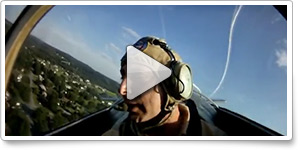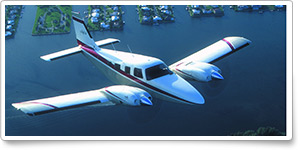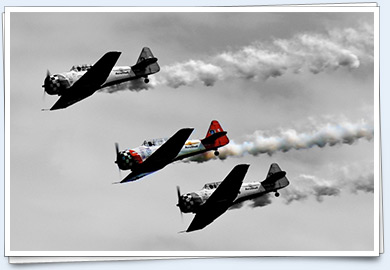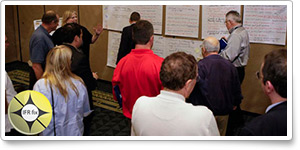Feb. 24, 2012, issue of 'AOPA ePilot: Flight Training Edition" newsletter
|
| ||||||
| ||||||
| Mush on the menu |
| |||||
Training TipsMush on the menu A glance at the altimeter brings more aggravation: 150 feet of altitude have slipped. When did that happen? Back at the airport, another dilemma is developing. A student pilot is landing a trainer, but has flared too high. The stall horn sounds, and the student adds some power to cushion the touchdown. But the remedy isn't enough, and the trainer flops to earth with a resigned clunk. Two different problems—but both with the same cause: The pilots failed to recognize that their aircraft had entered an aerodynamic twilight zone referred to as mushing flight. When practicing minimum controllable airspeed and the various stall recoveries, one of the most important lessons of the exercises is recognizing the various ways your aircraft communicates its aerodynamic condition. For example, not all stall entries are given away by an aural warning, buffeting, or a pronounced downward-pitching of the nose referred to as a stall break. If the critical angle of attack sneaks up on you with more stealth than is typically allowed during practice sessions, aircraft responsiveness to control pressures or power changes may deteriorate without big changes in aircraft attitude. That leaves the aircraft in the mushing condition that frequently leads to hard landings or altitude loss during slow-flight drills. You can recognize mushing flight by some specific cues. One is being unable to arrest a creeping descent while trying to hold a constant altitude during low airspeed flight. Another is a continued descent toward (or onto) the runway after you try to flare for landing. (A dissipating headwind component can also cause the problem.) Mushing poses the most danger if an aircraft on final approach is allowed to fly too deep onto the "back side of the power curve," where rapidly building induced drag could cause a stall/mush well above the ground. Similar risk could be encountered during a go-around, as this accident illustrates. A pilot who recognizes the early signs of decaying control effectiveness will avoid mushing or a stall. Drills that are safely focused on recognition of the condition are highly recommended! Flight Training NewsMachado joins March Flight Training chatFlight Training Contributing Editor Rod Machado will be a guest on the March Flight Training Facebook chat. Join Rod and the Flight Training editors on Thursday, March 1, from 3 to 4 p.m. Eastern, and bring your training-related questions and issues. To participate in the chat, log onto the Flight Training Facebook page and click on the chat link. View a transcript of previous chats. Afghan air force pilots complete first phase of trainingThey have mastered takeoffs and landings, lazy 8s, chandelles, and engine-out procedures—while carrying more on their shoulders than most student pilots. Seven newly minted air force officers, all natives of Afghanistan, celebrated on Feb. 2 the completion of their first phase of flight training. U.S. Air Force officials said this is the first undergraduate pilot training held inside the war-torn country in more than 30 years. Read more >> New ‘Ask ATC’: VFR flight plans and flight followingWhile they may sound similar, VFR flight plans serve a different purpose than IFR flight plans. When you file an IFR flight plan, air traffic controllers see the route you filed and try to conform to that request. But when you're flying VFR, you don’t have to stick to a predetermined route. So when you file a VFR flight plan and request flight following, can you assume controllers know your destination like they do with an IFR flight plan? Listen as air traffic controllers answer this question on the latest segment of the Air Safety Institute’s Ask ATC. K-State Salina students win Cessna scholarshipsTwo Kansas State University students are the recipients of Cessna Leadership scholarships. Carol Cooper of Hutchinson, Kan., and Megan Henderson of Topeka, Kan., will each receive $3,000, which they will use to obtain flight ratings. Both students are enrolled in the professional pilot program at K-State. Need help deciphering IFR chart lingo?How many times have you heard something similar to, “Anytown traffic, N1234, over Gumby, ILS 23, low approach only,” announced over the CTAF at a nontowered airport? As a student pilot or a VFR-only pilot, you may have no idea where this traffic is. But a good understanding of IFR charts can help you realize where others are as they practice their instrument approaches on good flying days. Take the Air Safety Institute's IFR Insights: Charts online course and get a better understanding of what other pilots are talking about when they refer to IFR chart references. Training ResourcesThe checklist is one of the least expensive yet most effective safety devices available in the cockpit. Not following a checklist could have dire consequences. Check out this informative article from Flight Training and continue to browse the magazine’s archives for a wealth of information to help you achieve your goal of obtaining your pilot certificate.
Did you know that student pilots who join AOPA are three times more likely to complete their flight training? Membership includes unlimited access to aviation information by phone (800/USA-AOPA, weekdays from 8:30 a.m. to 6 p.m. Eastern time) or from Flight Training Online or AOPA Online. If you're not already a member, join today and get the pilot’s edge. Login information is available online. Tumbling gyros Career PilotAirlines oppose White House budget proposalAirlines for America (A4A), the industry trade organization formerly known as the Air Transport Association of America, said Feb. 13 that the White House budget proposal “to offset the deficit on the backs of airline customers, by adding even more tax increases, would impact demand for air travel and ultimately cost jobs and service to communities.” A4A said the tax increase would reduce the number of passengers flying, which in turn will prompt airlines to reduce service, affecting hundreds of thousands of jobs in commercial aviation. Over the next five years, the White House proposes tripling the aviation security tax to $7.50 for each one-way trip, generating $18 billion that would be used for deficit reduction—not on aviation security. The proposal also seeks to add a new $100-per-flight tax; a portion of those proceeds also would go toward deficit reduction. United Continental, Delta share millions in profitsUnited Continental Holdings Inc. was to distribute $265 million in profit sharing on Feb. 14 to employees based on the combined full-year financial results of its subsidiaries, United Airlines and Continental Airlines. The company said it would pay eligible employees approximately 5 percent of their annual pay. In addition to profit sharing, employees of the combined company earned cash incentive payments totaling $40 million for on-time performance during 2011. In addition, Delta Air Lines told its 80,000 employees worldwide that they would receive profit-sharing payments totaling $264 million on Feb. 14, or 4.85 percent of their annual pay. Plane SpotterPiper Seneca: Training-suited twin Training ProductsCessna flight simulator controlsPilots who enjoy brushing up on their skills at home with a flight simulator can take it to the next level with a set of flight simulator controls. Sporty’s offers a special package of all three Cessna control systems—yoke, rudder, and trim wheel—plus Microsoft Flight Simulator X Gold edition, bundled together for $469.95, or you can purchase the items separately. See the website or call 800/776-7897.
Note: Products listed have not been evaluated by ePilot editors unless otherwise noted. AOPA assumes no responsibility for products or services listed or for claims or actions by manufacturers or vendors. Member BenefitsMedications update: FAA changes Nyquil-use guidelineIs Nyquil a staple of your medicine cabinet? Be advised that the FAA has changed its guidelines on how long you have to wait before you can fly an aircraft after using this common over-the-counter cold-relief medicine. Read more >> BlogsThe No. 2 radioYou no doubt have a routine in the cockpit where your airplane's No. 2 radio is reserved for monitoring guard (121.5 MHz), or perhaps ground communications only. How do airline pilots use the No. 2 radio? Find out in this week’s Flight Training blog. What would you do for a Thunderbirds flight?AOPA Online Managing Editor Alyssa J. Miller has applied for a media flight in the Thunderbirds No. 8 fighter during the upcoming Sun ’n Fun fly-in and airshow in Lakeland, Fla. She doesn’t yet know if she's on the list, but she does know what it feels like to try on men’s clothing at Walmart so that she could provide the Air Force with her men’s jacket, pant, and shoe sizes. Read more in this week’s Reporting Points blog. AOPA Career OpportunitiesEver dream of turning your passion for aviation into a career? We’re looking for an associate project manager, online product manager, marketing specialist–products, aviation education program developer, accounting manager, and associate editor–Web/ ePilot. To learn more about other AOPA career opportunities, visit AOPA Online. Community
AVIATION EVENTS & WEATHER
| ||||||||||||||||||||||||||||||||||||




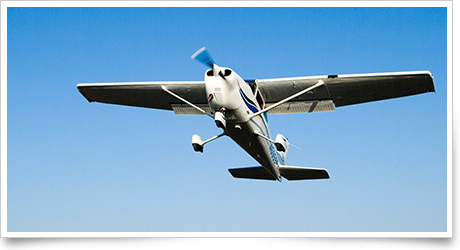 A trainer is wallowing through the air at minimum controllable airspeed, its pilot struggling to maintain heading and altitude as induced drag and unresponsive controls work mischief on the exercise.
A trainer is wallowing through the air at minimum controllable airspeed, its pilot struggling to maintain heading and altitude as induced drag and unresponsive controls work mischief on the exercise.